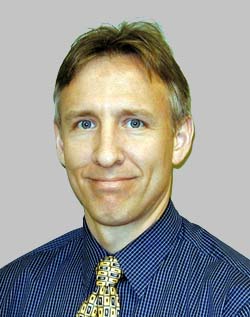
 | Chapter Chatter |
Todd Hubing, Associate Editor |
| Going to Zurich in February? How about Montreal in August?
These are two EMC symposia you won't want to miss. The state-of-the-art in EMC
is advancing at a rapid pace. This past year at the symposia in Washington DC
and Brugge, I was amazed at the amount of progress reported in a number of areas.
Design rules and EMC design practices that were once widely accepted and applied
are being debunked and replaced continuously. The overall quality of the research
being done and the papers being presented is increasing steadily. If you haven't
attended an EMC symposium in the past couple years, you might be missing information
on tools or techniques that could significantly improve your productivity. There was a record turnout at the Washington symposium. Not only was the technical program excellent, but the conference was well organized and fun too. Did you know that Washington DC is the Country Music Capital of the World? I didn't. I always thought the Country Music Capital was further west. Nevertheless, at the symposium I heard several people comment that Washington DC was in fact the Country Capital. Being at an EMC symposium in the Country Music Capital of the World inspired me to write a song about EMC. Of course, I don't know very much about song writing or country music, so I had to do a little research. As near as I can tell, the thing that makes country music different from other music is mostly the subject matter. Country music usually tells a story incorporating the following elements:
To write a country song, these elements should be folded into a story that is interrupted frequently by a nonsensical chorus. Combine this with a catchy rhythm and an intentional lack of sophistication, then throw in a few twangs of a steel guitar and you're sure to have a hit song. Here's my first attempt. Of course, since you're reading this in a newsletter, you'll have to imagine the music. Fortunately, most country music songs are pretty much the same so you can substitute any country music melody that employs roughly the same number of syllables per line. Just remember to sing the verses with a slightly monotone voice and then wail as if you'd just been kicked by a horse when you get to the chorus. Also, when you see a "...", imagine a long twang on a steel guitar. My Wife Left Me for 3 dBI love my wife and she loves me. One
day I promised I'd be home by three. [chorus] When I got home I found a note on the door. She said, "Time is
money and money is power [chorus] I found my wife
at the home of her mother. She said, "Where
have I heard that before. [chorus] I convinced my wife to come with me, ... [extra steel guitar
twang inserted here to reflect the passage of time.] [chorus]
...
[Final twang of steel guitar to drive home the irony So what do you think? If you didn't like it, it's probably because you don't like country music. Or maybe it's because you couldn't hear the melody. I'd be happy to bring my steel guitar to your next chapter meeting and play this song for you. I heard that Johnny Cash started out this way. Perhaps I have a future in the country music business. On second thought, never mind. I can't imagine anything more fun or rewarding than being an EMC engineer. |
David Dennis, Chair of the Atlanta chapter, reports that their last meeting was held in June and featured a presentation by Donald J. Sherratt of Intertek Testing Services. Don is a renowned expert in medical device technology and standards activities. His discussion was entitled "EMC and Medical Devices", and it covered a broad range of related topics. For more information on upcoming meetings you can check the Atlanta Chapter's website at https://www.ewh.ieee.org/soc/emcs/atl/atl-emc.htm or subscribe to the chapter's e-mail list. Instructions to join the list are on the website.
John Clarke, chair of the Central New England chapter, reports that the chapter organized an EMC session for ELECTRO 2000 in Boston. Invited speakers presented the following four papers on Wednesday, June 14, 2000 at the Bayside Exposition Center, Boston, Massachusetts.
The first paper was "Overview of the European Union Radio Equipment and Telecommunications Terminal Equipment (R&TTE) Directive" presented by Denise Haley of Agilent Technologies. Her presentation provided a comprehensive review of the EU R&TTE Directive effective on April 8, 2000 for all radio and telecommunications products being marketed in the European Union.
The second paper was "IEC STD 660601-1-2 Safety Standard Dealing with EMC/EMI Issues Applied to Medical Electrical Equipment" presented by Jim Conrad, also from Agilent Technologies. His talk provided an overview of the International Electro-technical Commission (IEC) Standard 60601-1-2; Second Edition EMC for Medical Electrical Equipment. IEC 60601-1-2 is currently under development by IEC and is expected to be published as an IEC and European Norm in 2001. The FDA is also planning to adopt the standard as soon as it is released.
The third paper was titled, "Adverse Interactions Between Medical Devices and Electronic Article Surveillance (EAS) Systems, Metal Detectors and Security Systems." It was presented by Jon Casamento, FDA Center for Devices and Radiological Health, Rockville, MD. During the last decade the U.S. Food and Drug Administration (FDA) received more than 70 medical device-reporting incidents of adverse interactions between medical devices and electronic article surveillance systems (EASS), metal detectors, and security systems. Several case reports and four peer-reviewed studies documented adverse interactions between EASS and implanted pacemakers, and other implanted medical devices. The speaker discussed an FDA study that provided data to characterize electromagnetic (EM) fields generated by EASS. These data are used for susceptibility testing of various ambulatory medical devices to EM fields emitted from EASS.
The final paper was titled, "CASSPER EMI - Ambient Cancellation and Source Localization System." It was presented by Kevin P. Baldwin, EMC Test Systems, L.P.Norwalk, CT. The CASSPER System effectively brings an Open Area Test Site (OATS) into the engineering department, test lab or the production floor, measures EMI and determines compliance at any location. The speaker provided a description and demonstration of the operational system. CASSPER is a new PC-based instrumentation system that records and isolates EUT signals of interest without the need for anechoic chambers. The system delivers true ambient cancellation and removes the guesswork in EMI signal identification. The product's source localization measurement feature allows you to identify and locate sources of EMI noise including multiple sources at the same frequency.
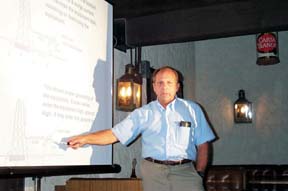 |
Jack Opocensky of Polyphaser
Corp. explains the concept of single-point grounding for communications shelters. |
Harry Gaul reports that the Phoenix EMC Chapter held their September meeting with a presentation on lightning protection by Jack Opocensky of Polyphaser Corporation. Jack began his talk with a review of how lightning is formed and a discussion of the myriad of lightning specifications. Jack explained that the fundamental principle for lightning protection of communications shelters is to group all the power, coax, and signal penetrations together. Then a single-point ground with lightning protectors can be provided for these penetrations at the entrance to the building with the goal of shunting all currents to ground outside the building. This will reduce the likelihood of damaging currents flowing through electronics within the building. A separate "halo" ground can be provided within the building to provide safety protection to the occupants. The halo ground provides a path to ground for the surge currents induced in doorframes, window frames, and other structural elements. But the halo ground must not be used as a signal or power ground for the electronics. The thirty attendees really appreciated Jack's talk and now have a better understanding on designing communications shelters to withstand lightning.
The Phoenix chapter is making plans to host a one-day EMC colloquium on May 7th, 2001. Check out our web site at https://www.ewh.ieee.org/r6/phoenix/phoenixemc for the latest schedule on upcoming talks.
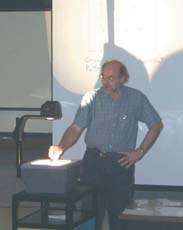 | 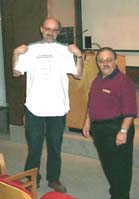 |
At the September meeting of the Rocky Mountain EMC chapter, Professor Kuester analyzes a problem for the audience. | Professor Kuester (r) displays
Maxwell's Equations on his |
Charles Grasso reports that the September meeting of the Rocky Mountain chapter featured a talk entitled, "Can Just Anyone Understand Electromagnetic Fields?" presented by Professor Edward Kuester from the University of Colorado at Boulder. This talk was part seminar, part tutorial and part give-and-take with the audience. Historically, an electrical engineer's education provided a solid background in circuit analysis, and touched somewhat on other subjects (like computers, power conversion, electromagnetics, etc.). Much of what a working engineer was called upon to do could be accomplished by building on this foundation of circuit theory. As our use of the frequency spectrum pushes ever higher (1-GHz computer processors, cell phones at microwave bands, and so on), designs can no longer be made purely on the basis of classical circuit concepts. Professor Kuester tells students in the beginning electromagnetics class that EM fields are really the basis of everything we do outside the quantum level in electrical engineering. Does this mean that you have to be an expert in EM to design anything these days? Or can the impact of Maxwell's equations be understood in a simpler way, using ideas already familiar from electric circuits?
Twenty-eight intrepid folks turned up to see Professor Edward Kuester emphatically give a "yes" answer to the second question. He looked at several issues that arise in practical applications (use of computers to calculate fields, the effect of EM fields between neighboring circuits, and others) and showed how readily understood techniques of circuit analysis can be used to deal with these problems.
Professor Kuester started his talk right at the beginning – Maxwell's Equations. He briefly reviewed the four equations and showed that although most engineers are concerned with approximating Maxwell's equations, they are themselves an approximation of quantum electrodynamics. He then re-viewed some of the basics of field theory as a reminder and as a nice lead in to how, by keeping element size small with respect to a wavelength, lumped-circuit theory can be obtained from EM fields. Professor Kuester then traveled back in time to 1850 and introduced Lord Kelvin who developed the telegraphers equations, an analytical connection between circuits and fields. He then posed the question – Can we go the other way? That is, from fields to circuits? The answer was yes, by taking the finite difference approximation for Maxwell's curl equations in all three space directions. A circuit was then shown that approximated the field description with the advantage that the circuit can be analyzed using SPICE and similar computing tools. Professor Kuester then discussed the numerical computation of fields with some of the advantages and drawbacks. Keeping to the focus of talk, Professor Kuester then analyzed printed circuit traces and described a way of making a "real" circuit model that models the actual currents on the traces rather than fields that most people have little interest in. He described the PEEC or Partial Element Equivalent Circuit Method and walked the audience through the connection between fields and circuits. He really stirred up the pot with a discussion of partial inductance. At the conclusion of his talk, Professor Kuester opened up a discussion with the audience and fielded questions for about an hour.
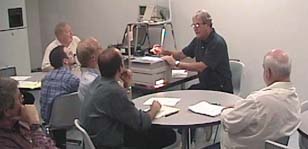 | 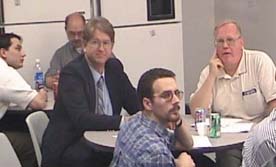 |
Tom
Van Doren was the speaker at the September Seattle chapter meeting. Note the demo
equipment in the background (and on the chair) which was used throughout the evening
to supplement the | The
winners of the "Noise Diagnostic Competition" held following Tom Van
Doren's presentation at the Seattle chapter meeting in September. The winning
team consisted of Joe Mason (front center) and Mark Chase (left) of CKC Labs and
Dennis Anderson of the FCC (right). |
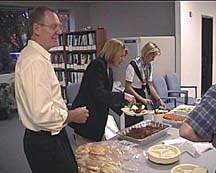 |
Dinner
was personally and cheerfully served at the September Seattle chapter meeting
by (from left) Leo Smale and Jeannie Olson of Kalmus and Janet O'Neil, Chairman
of the Seattle chapter. |
In July, the Seattle chapter held a special joint technical meeting with the members of ANSI-ASC C63 who happened to be meeting at the AT&T Wireless facility in Redmond. The title of the presentation was "Multimedia – It's Not Just ITE and TV Anymore." The speakers were Dave Traver and Ian Matthews of Sony in San Diego, CA. The presentation covered various aspects of multimedia and its effect on EMC measurement standards. EMC issues (is it consumer electronics or is it ITE?) were presented. The question was posed: What will the new standards need to measure? The meeting was held at CKC Labs, who generously treated the attendees to a catered dinner prior to the technical presentation. It was a unique opportunity for chapter members to informally mix with the members of the ANSI-ASC C63 committee, many of whom came to Redmond from all over the US.
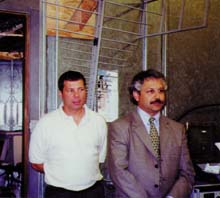 | 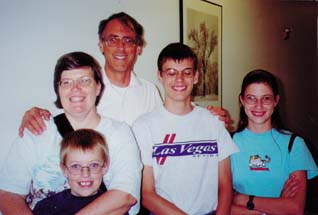 |
In July the Seattle Chapter held a special meeting
with members of ANSI-ASC C63 in attendance. The meeting included a tour of the
CKC Labs facilities in Redmond, which Dennis Camell of NIST and John Lichtig of
Lichtig EMC Consulting (L-R) enjoyed seeing. | Doug
Smith brought his family with him to the July C63 meetings in beautiful Redmond.
The Smith family consists of parents Deborah and Doug with kids David, Doug Jr.,
and Didi (L-R). |
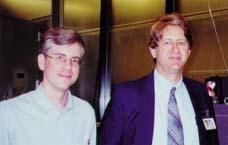 | 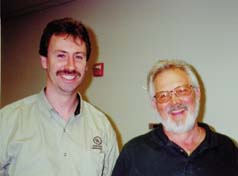 |
John Hirvela of Compaq joined Mark Chase (L-R) of
CKC Labs at the special July meeting of the Seattle Chapter. | Also attending the Seattle Chapter meeting
while in town for the C63 meetings were Bob DeLisi of Underwriters Laboratories
and Carl Felts of Intertek Testing Services (L-R). |
There was a good turn out for the September chapter meeting with speaker Tom Van Doren from the University of Missouri at Rolla. At the Kalmus facility in Bothell, he presented "How to Diagnose Electrical Noise Problems." He began his presentation with the statement "There are only four basic EMC problems that keep happening again and again. And they're the same problems regardless of the industry you're in!" The evening focused on these four problems with diagrams and demonstrations of the material presented. At the end of the presentation, teams of three were created for the "Noise Diagnostic Competition." The teams were given noise diagnostic problems to solve in a limited amount of time. After completing the problem, a team would hand their results to another team to grade. Some four problems were presented and solved with titles such as "Noise Activation of a Sensing Circuit" and "Radiation from a Handheld Computer". The winning team members were Mark Chase and Joe Mason of CKC Labs and Dennis Anderson of the FCC. Congratulations Mark, Joe and Dennis! This meeting started at 4:00 pm and ended at 8:30 pm, with a short dinner break in between. With the expert presentation by Tom, the delicious dinner from Texas Smokehouse of Hollywood, and the fun competition, it was a long, but great chapter meeting.
Dr. Siou Teck Chew reports that in Singapore, EMC is part of a joint EMC/AP/MTT chapter. Professor See from the Nanyang Technological University has undertaken the task of forming an independent EMC chapter. The Joint Chapter welcomes this move, as the activities organized by the new chapter will be more focused and beneficial to EMC members. Professor See is in the process of seeking signatures from IEEE EMC Society members and setting up the chapter. EMC